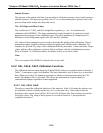
Teledyne API Model 200AU NO
X
Analyzer Instruction Manual, 02293, Rev. F
5-16
5.2.2.6 Automatic Converter Efficiency Compensation
The M200AU can automatically compensate the NO
x
and NO
2
readings for the molybdenum
converter efficiency. There are 2 ways to enter the converter efficiency into the instrument. The
first is to just type in the converter efficiency using the CAL-CONC-MOLY-SET menu. The
second method is to have the M200AU compute the efficiency using the CAL-CONC-MOLY-
CAL menu. See the Calibration Section 7.6.6.1 Molybdenum Converter Efficiency for details.
To disable the compensation, press CAL-CONC-MOLY-SET and enter 1.0000 as the efficiency.
Factory default is 1.0000.
5.3 Set-Up Mode
5.3.1 Configuration Information (CFG)
This menu item will tell if the installed software has factory special features or other non-
standard features. If you call Teledyne API service you may be asked for information from this
menu.
5.3.2 Automatic Calibration (AutoCal)
The AutoCal feature allows the M200AU to automatically operate the Zero/Span Valve option to
periodically check its calibration. Information on setting up AutoCal is in Section 6.3.
5.3.3 Data Acquisition System (DAS)
The M200AU contains a flexible and powerful built in data acquisition system (DAS) that
enables the analyzer to store concentration data as well as diagnostic parameters in its battery
backed memory. This information can be viewed from the front panel or printed out through the
RS-232 port. The diagnostic data can be used for performing “Predictive Diagnostics” and
trending to determine when maintenance and servicing will be required.
The logged parameters are stored in what are called “Data Channels.” Each Data Channel can
store multiple data parameters. The Data Channels can be programmed and customized from the
front panel. A set of default Data Channels has been included in the M200AU software. For
more information on programming custom Data Channels, a supplementary document containing
this information can be requested from Teledyne API.


















